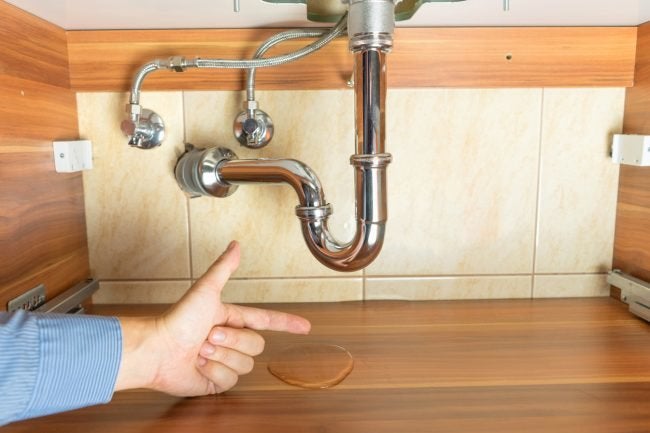Overview To Water Leak Detection At Home
Overview To Water Leak Detection At Home
Blog Article
This great article listed below relating to Finding hidden leaks is exceptionally enjoyable. You should look it over.

Early detection of dripping water lines can minimize a potential disaster. Some small water leakages may not be visible.
1. Take A Look At the Water Meter
Every home has a water meter. Examining it is a guaranteed manner in which assists you discover leaks. For starters, shut off all the water sources. Ensure no one will certainly flush, use the tap, shower, run the cleaning maker or dishwashing machine. From there, most likely to the meter and also watch if it will alter. Given that no person is using it, there need to be no motions. That suggests a fast-moving leakage if it relocates. Furthermore, if you detect no changes, wait an hour or 2 and inspect back once more. This means you may have a sluggish leakage that could even be underground.
2. Inspect Water Consumption
Evaluate your water bills and also track your water usage. As the one paying it, you must discover if there are any type of disparities. If you detect sudden changes, despite your consumption being the same, it means that you have leakages in your plumbing system. Bear in mind, your water bill need to fall under the same variety each month. An abrupt spike in your bill suggests a fast-moving leak.
A constant boost every month, also with the exact same behaviors, shows you have a slow-moving leakage that's also gradually escalating. Call a plumber to thoroughly examine your building, especially if you feel a warm area on your flooring with piping underneath.
3. Do a Food Coloring Examination
When it concerns water usage, 30% comes from bathrooms. Examination to see if they are running correctly. Decline flecks of food shade in the tank as well as wait 10 mins. There's a leak between the tank as well as bowl if the shade somehow infiltrates your dish during that time without flushing.
4. Asses Exterior Lines
Don't fail to remember to inspect your outdoor water lines also. Test faucets by attaching a yard hose pipe. Ought to water permeate out of the connection, you have a loosened rubber gasket. Change this as well as ensure all connections are limited. If you have actually got a sprinkler system, it will certainly aid get it professionally examined and also kept each year. One little leakage can lose tons of water and also increase your water expense.
5. Evaluate as well as Examine the Circumstance
Homeowners ought to make it a practice to check under the sink counters as well as also inside cabinets for any type of bad odor or mold growth. These two red flags show a leakage so prompt interest is needed. Doing routine inspections, even bi-annually, can save you from a significant problem.
Check for discolorations and also deteriorating as a lot of pipelines as well as home appliances have a life span. If you suspect leaking water lines in your plumbing system, do not wait for it to rise.
Early discovery of leaking water lines can alleviate a possible disaster. Some tiny water leakages might not be visible. Inspecting it is a guaranteed way that helps you find leakages. One little leak can waste lots of water and spike your water costs.
If you believe leaking water lines in your plumbing system, don't wait for it to rise.
WARNING SIGNS OF WATER LEAKAGE BEHIND THE WALL
PERSISTENT MUSTY ODORS
As water slowly drips from a leaky pipe inside the wall, flooring and sheetrock stay damp and develop an odor similar to wet cardboard. It generates a musty smell that can help you find hidden leaks.
MOLD IN UNUSUAL AREAS
Mold usually grows in wet areas like kitchens, baths and laundry rooms. If you spot the stuff on walls or baseboards in other rooms of the house, it’s a good indicator of undetected water leaks.
STAINS THAT GROW
When mold thrives around a leaky pipe, it sometimes takes hold on the inside surface of the affected wall. A growing stain on otherwise clean sheetrock is often your sign of a hidden plumbing problem.
PEELING OR BUBBLING WALLPAPER / PAINT
This clue is easy to miss in rooms that don’t get much use. When you see wallpaper separating along seams or paint bubbling or flaking off the wall, blame sheetrock that stays wet because of an undetected leak.
BUCKLED CEILINGS AND STAINED FLOORS
If ceilings or floors in bathrooms, kitchens or laundry areas develop structural problems, don’t rule out constant damp inside the walls. Wet sheetrock can affect adjacent framing, flooring and ceilings.
https://www.servicemasterbyzaba.com/blog/how-to-detect-water-leakage-in-walls/

Do you appreciate reading about Detecting hidden plumbing leaks? Make a review down the page. We would be interested to hear your suggestions about this write-up. Hoping that you visit us again before long. Kindly take the opportunity to promote this blog post if you appreciated it. Thanks a bunch for your time. Come back soon.
Report this page